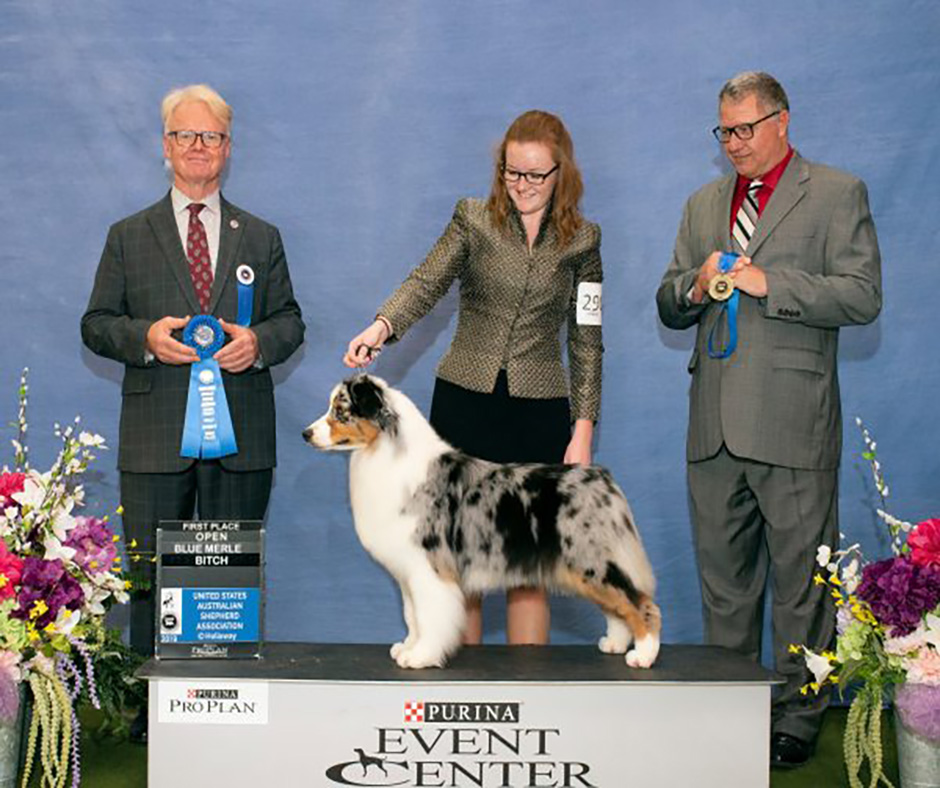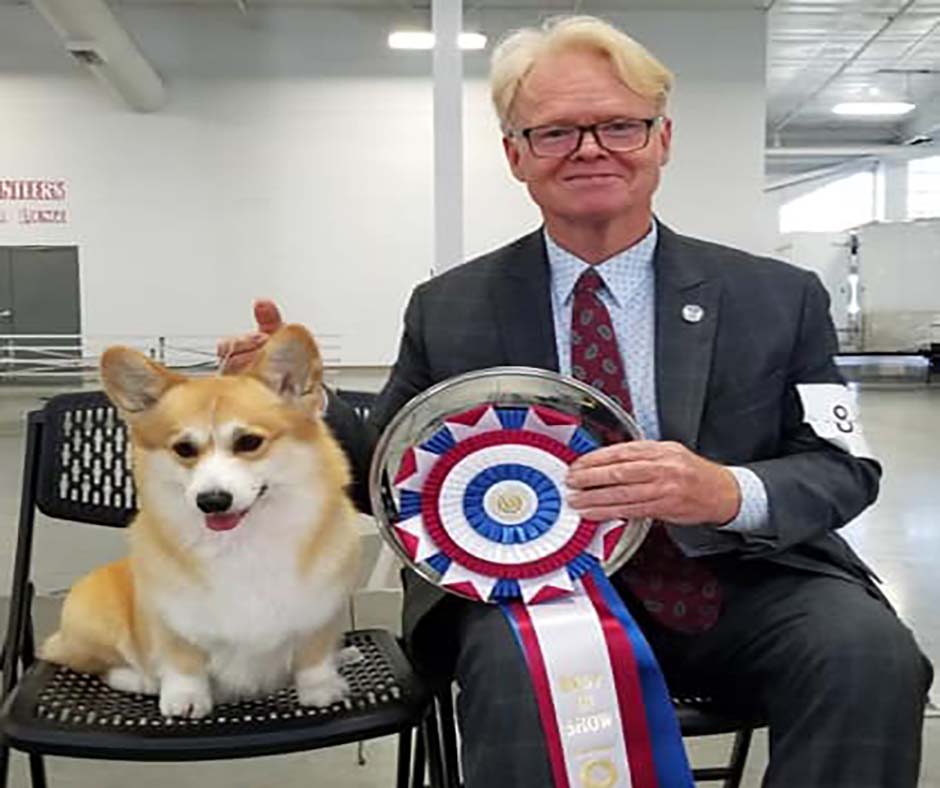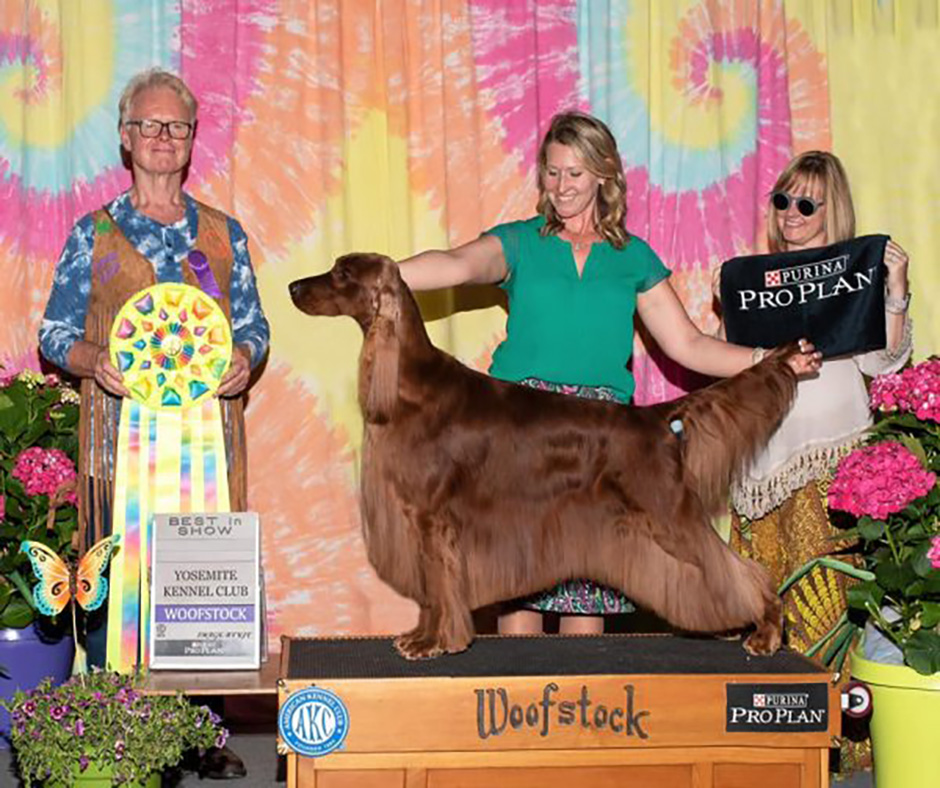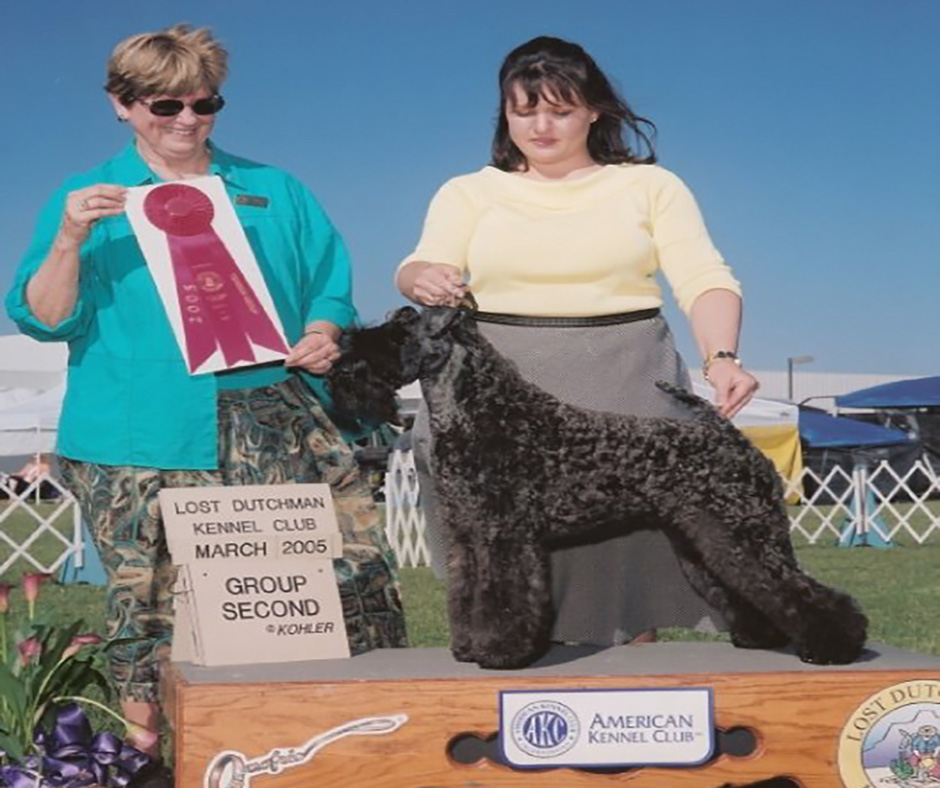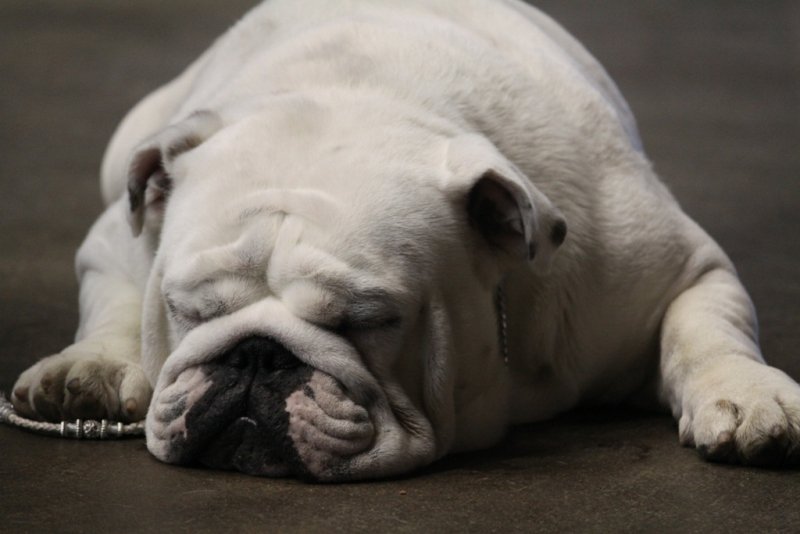309 — Breeding for type, consistency while keeping a low COI
Breeding for type, consistency while keeping a low COI
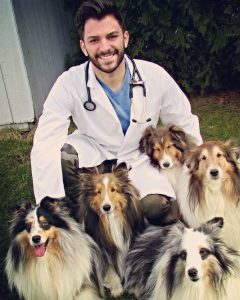
Dr. Victor Stora, veterinary medical geneticist, with some of his Shetland Sheepdogs.
Victor Stora, Shetland Sheepdog breeder, AKC/CHF Residency Recipient and Veterinary Geneticist at University of Pennsylvania, shares concrete information on breeding for type and consistency of style while keeping a low COI (Coefficient of Inbreeding).
Stora observed that many breeders fall in to one of two categories.
“People might fall in to health testing too much and losing type, or you have people ignoring health because they’re getting the type they want. The happy medium is where people should be,” Stora said.
Health test all you want, Stora noted, but keep in mind it doesn’t mean the dogs are free of disease… just all the ones you can test for. What are the really bad diseases that affect a breed, he queried, adding that the more “lethal” diseases get higher priority.
Health testing and COI are tools
“Once you get to the point that you have the animals that you’ve screened, choose the ones that have the least problems health testing wise and are most like the type you desire,” Stora recommended. “Health testing is a tool, not a meter to eliminate animals because they don’t pass the bar.”
He also strongly recommends incorporating carriers of some diseases in a breeding program. “If you eliminate carriers, assuming the carrier has no disease, you’re removing dogs that are healthy. You can zoom in *too* much on health testing, and lose what you had in the beginning.”
We don’t have all the answers yet
Stora also noted that the primary diseases we want to know about, epilepsy, cancer etc, we don’t have an answer and that they are likely environmental, plus genetic.
When it comes to autoimmune disease, Stora said the breeder’s goal is to have more genetic variation to combat it.
“Outcross to a point, line breed to a point. Watch what’s happening. If you don’t choose for fertility, you’re choosing against it. Fertility is a heritable trait,” Stora said. “Nobody got into this because it’s easy. It’s not.”
Finally, Stora counseled to stop breeding affected dogs once the breed or line has started making headway against that disease.
“If the disease is rare within a breed, never breed affected because you don’t have to. If it is common within the breed, you have to use affected,” Stora said.
Our goals as breeders, Stora noted, should be to breed with knowledge, move with testing, breed away fromthe disease state, lower the frequency you see the disease causative allele. Move toward a goal of no disease.
308 – Bill Shelton, chapter 3: bottlenecks, marketing, adaptability
Bill Shelton, chapter 3: Genetic bottlenecks, marketing, adaptability
Renowned breeder and judge Bill Shelton and host Laura Reeves finish up their wide-ranging conversation on dog breeding and marketing in the 21st century.
“How do we move the bar from healthier to typier to sounder? We have to breed,” Shelton said. “We have to be accountable for what we produce. But we have to breed. And we have to get the message out about how what we’re doing is producing healthier and happier dogs. How our ‘commodity’ is predictable.”
Bottlenecks are something we may all have to deal with at some point, Shelton noted. He references the Dalmation outcross project in which Pointers were incorporated to eliminate a deadly disease. He also talks about the Basenji project, in which native dogs from Africa are incorporated in the gene pool, again to eliminate a heritable disease. Listen to my interview with Damara Bolte on this topic here.
“It’s a heretic idea to many people, but it’s going to be something we all have to do at some point, because our dogs exist in closed gene pools,” Shelton said. “It goes back to the weaving of genes. You don’t eliminate bad genes, you introduce new good genes.”
Additional resources:
https://puredogtalk.com/busting-the-genetic-testing-myths-dr-jerold-bell/
https://puredogtalk.com/77-one-breed-one-world-think-and-breed-global-with-doug-johnson-2/
https://puredogtalk.com/german-pinscher-all-purpose-robust-dog-for-active-owners-pure-dog-talk/
Doodles offer a lesson
“How many people dislike labradoodles. Think back in the ‘70s when there were those dogs called Australian shepherds,” Shelton noted wryly. “People get upset because doodle breeders can sell their cross-bred dogs, when they (show breeders) can hardly sell dogs. Why? Because (show breeders) exist in a vacuum. They don’t advertise, they don’t promote their breeds, they don’t promote themselves, they don’t know how to do it. And then they say how bad AKC marketplace is. We want to show our dogs. But we don’t want to share them or market them.”
No dog left behind
Shelton espoused several outstanding marketing concepts, including making a dog’s microchip number its registration number. The public finds more value in the microchip than the registration number, he said. This plan would enable AKC to sell both more registrations and microchips and promote a campaign of “no dog left behind” because all purebred dogs would be registered and microchipped.
The entire series
If you missed the first two installments of this series, you can find them here and here.
307 – Bill Shelton, part 2: Breeding for Genetic Diversity
Bill Shelton on Breeding for Genetic Diversity, Breeding Up and More
In part two of our series, Bill Shelton, leading advocate for preservation dog breeders, and host Laura Reeves have a spirited conversation about how to improve the health of our breeds while maintaining genetic diversity.
“Leading theriogenologists say breeders are suppressing genetic diversity,” Shelton said. “Only testing phenotype not genotype in hip x-rays for example, removes dogs from the gene pool without understanding the genotype. When we eliminate genes for one thing we don’t know what genes we’re removing that are positive.”
Lethal genes must be removed, but until we have a DNA genetic marker we don’t really know, Shelton noted. We need to breed carriers and potentially affected as well in order to preserve a variety of genes for the future.
Weaving genes to make a healthier dog
“We are asking more of our dog breeding programs than we are for our own humanity,” Shelton said. “We’re actually holding dogs to a higher standard than ourselves and the future of humans.”
Taking the conversation full circle, Shelton noted that legislators are listening to extremists rather than experts in animal husbandry.
Messaging… Again!
“We need to get our message out there,” Shelton said. “We need to have more advocacy for purebred dogs. We need to step outside this circle of dog shows.”
In an outside-the-box idea, Shelton suggested that AKC needs to consider rebranding as an option, to call themselves a conservancy of heritage breeds.
“How we talk about what we do is what’s important,” Shelton said.
In the “other great ideas department,” Shelton asked rhetorically, “Where is the breeder’s committee in the delegates? Where is the VP of breeders at AKC?”
“We need to take the focus away from showing and put our focus on breeding dogs,” Shelton said. “We are at the point that an amateur delegate body is running what has become a professional industry. Everyone makes money. Who doesn’t make money? Dog breeders.”
If you missed part 1, listen here.
306 – Bill Shelton on Positive Messaging in Purebred Dogs
Bill Shelton on Positive Messaging in Purebred Dogs
Bill Shelton imparts his wisdom in part one of a three-part series from a wide-ranging conversation about positive messaging in purebred dogs.
People respond to positive messages, Shelton said, which will allow us to change perceptions within the general public. Words like preservation and purpose bred dogs change the paradigm of purebred that can have negative connotation.
“Look what shelters have done,” Shelton said. “They used to be known as the dog pound and mongrels. Look at it today, shelter, rescue, adoption. What fabulous words they use. We still use all these draconian words like kennel, breeders and purebred. They are accurate, but we need to move past them. Even the boarding industry has recognized the anthropomorphized words and have day care and stylists instead of kennel runs and groomers.”
We as breeders and exhibitors have the responsibility to take back the conversation and can’t rely exclusively on the American Kennel Club to do the work for us, Shelton noted.
“I don’t use the word responsible any more because 30 people have a different understanding of what that means,” Shelton said. “Purpose bred means that not only are the dogs bred for intellect and the way they look and predictability, they are bred intentionally by people who care about them.”
The term preservation breeder opens up the opportunity for conversation in the community, Shelton said.
“The paradigm has to change,” Shelton said. “We’ve focused so much on dog shows, that we began to believe that is the most important thing. What’s really important is that you and I as dog breeders supply the demand of happy, healthy family companions.”
Accountability
“As breeders, we are taking accountability,” Shelton said. “We are the ones taking responsibility from cradle to grave. The rescue started in the halls of the AKC and parent clubs. This is one of the reasons we find only five percent identifiable purebreds in shelters.”
We have to assimilate different perspectives rather than pushing against them, Shelton said. We need not to demean people but rather encourage them to understand what preservation breeders are doing, including producing quantitative predictability of health.
Learn more: 23 – Our Breeds are Endangered: Preservation Breeding-Bill Shelton
305 — Anne Katona on judging, retirement, owner handlers
Anne Katona on judging, retirement, owner handlers
Long time judge Anne Katona shares her insights about judging, announces her planned retirement in January 2021 and offers encouragement for owner handlers.
Famous for her greetings in the ring, where she reminds every exhibitor that “wiggles are allowed,” the perennially cheerful Katona noted that she’s “never known a wiggle to hurt bone structure. Why do they have to be little robots?”
“I want everybody who walks out of my ring to say, I didn’t win, but it’s ok, I had a good time” Katona said.
Tips for Owner Handlers
Katona’s history as a breeder and owner-handler of Kerry Blue Terriers leaves her with an affinity for new folks and owner handlers. Her tips for them:
- New people in the ring: Stand up straight, take a deep breath, and realize every person in this ring has been in your place.
- In the group – take care of your dog, play with your dog, have fun, don’t just stand there with the dog on the end of the lead and hand on your hip
- Take a couple seconds, go to corner of ring and then go around after the down and back. You’re cheating yourselves out of 30-50 feet of the dog being seen. And judges need to see how do the dogs take off and how they get their feet under them.
- Owner handlers can be competitive if they take the time to train the dog.
- Most important thing an owner handler can own, other than their dog, is a mirror… buy a full length mirror, put it on the wall horizontally at the level of your dog’s height, watch the dog in a free stack.
- People with table breeds, work with them, let them walk forward, don’t just pick them up and plop them down. Not judging dogs on the table, just examining.
- Don’t suffocate your dogs by stacking and leaning over them. Hand stack, stand back, don’t bend over the dog.
- Do you want the truth? A lot of people don’t want to hear the truth because their ego is attached to that dog.
304 – Bulldogs, professionals and imprinting type with Jay Serion
Bulldogs, professionals and imprinting type with Jay Serion

Jay Serion and Brix… Photo by Ryan Estrada Photography
Specialist Jay Serion talks about bulldogs, having pride as a handler, starting in the trenches and establishing a vision of type from understanding the standard.
“At my first dog show, my dog was third out of three,” Serion said. “I came out of the ring thinking, ‘we need to remedy this.’ Cuz I was competitive. I learned a lot.”
Serion’s recipe for success:
- Do the work outside the ring.
- Fix it in the whelping box not the tack box
- Start in the trenches. Success is not an overnight thing
“My mentors were honest,” Serion said. “They told me to read the standard. Learn the standard. Study pedigrees. Ask people. Ten people will give you 10 answers. There will be a common denominator, that’s your truth.”
Professional handlers all have a bar set of the quality they want to present, Serion noted.
“Especially if you are a specialist, it is part of your responsibility to campaign a good one,” he added. “I don’t want to waste money and time. And it takes a lot of both. I’d rather wait for a great one than push one that people that know *know* isn’t.”
A Bulldog Club of America approved mentor, Serion shares his knowledge about the breed’s outline and appearance.
“They’re supposed to be athletic. In my breed, the standard was written to save the breed from an influx of “Spanish dogs” that were huge,” Serion said. “The perfect bulldog must be of medium size. This was not arbitrary.”
Layback isn’t just for shoulders
The Bulldog standard is unique in that the term “layback” refers to the head structure. Serion describes this very specific construction as being from the tip of the lower jaw, tip of the nose, through the forehead to the occiput, should be a 45 degree angle in a straight line.
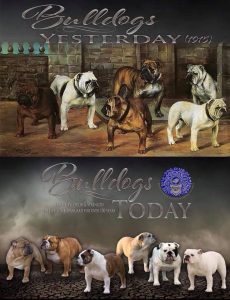
Illustration of the Bulldog then and now courtesy of the Bulldog Club of America.
“The dogs were used in bull baiting. The jaw needed to be strong enough to grab on to a bull and hang on, while the nose was pushed back so they could hold on and still breathe,” Serion siad.
Brachycephalic
“Our dogs are just as healthy as other breeds,” Serion said. “We’ve created an Ambassador of Health program in the national club encouraging health clearances.”
The program was created to provide proof of healthy dogs, testing everything from tracheas, to cardio, patella, spine, hips, elbows and more, Serion noted.
Temperament
Bulldogs originally were an aggressive animal to do the job, Serion observed. The original breeders wanted to keep the type features but eliminate aggression. “I’d never breed an aggressive animal no matter how pretty it is.”
For more on the genetics of temperament: https://puredogtalk.com/dr-karen-overall-temperament-vs-geneticspure-dog-talk/
303 – Canine dentistry: What you need to know about oral health
Canine dentistry: What you need to know about oral health
By listener request, here’s everything you need to know about oral health with Veterinary Dental Specialist, Dr. Jeff Schreiber.
“Periodontal disease is very painful for the dog,” Schreiber said, but “Our pets are stoic. They don’t show pain very well.”
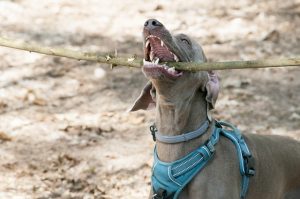
Image by Romuald Gałęcki from Pixabay
Schreiber emphasizes that the best cure is prevention. Daily tooth brushing, Chlorhexaderm oral rinse and appropriate chew toys are the secret to success.
“Plaque is the enemy,” Schreiber noted. Visit this site for a list of great products from chews to rinses to food choices: http://vohc.org/VOHCAcceptedProductsTable_Dogs.pdf
Signs of a problem:
- bad breath
- not eating as well
- blood on chew toys
- dropping food out of mouth, prefer soft food
Schreiber strongly advocates regular dental cleanings while the pet is anesthetized. The veterinarian will pull blood work and should take xrays of the mouth. “60% of tooth structure is under the gum line,” Schreiber noted. “Good hygiene at home saves money on cleanings.”
“Dogs are supposed to have 42 teeth. Each tooth is a patient in and of itself,” Schreiber said.
Dental Emergency
Breaking a canine is an emergency.
“If we can catch it within the first day, you have a window where we can save the tooth and save the dog from a root canal. Breaking the tooth is an open wound. It needs to be dealt with, even if it is after the fact and needs a root canal. For folks who want the tooth to look good as new, the tooth can be crowned,” Schreiber said.
Dr. Schreiber is a graduate of Kansas State University College of Veterinary Medicine, class of 1981. In February 1991 he opened Miracle Hills Animal Hospital. In January 2018 Dr. Schreiber merged his practice into VCA 80 Dodge Animal Hospital. His primary practice interests include advanced dentistry, internal medicine and junior and senior wellness care. Dr. Schreiber is also a member of the Foundation for Veterinary Dentistry. Outside of the practice he enjoys showing his dogs in AKC obedience trials, camping, golfing and spending time with his family. He and his wife have two grown children and three grandchildren. He can be contacted at Jeffrey.schreiber@vca.com
302 – Vet Voice: Pre-breeding Protocols, Folic Acid and More
Pre-breeding Protocols, Folic Acid, Cleft Palate and More
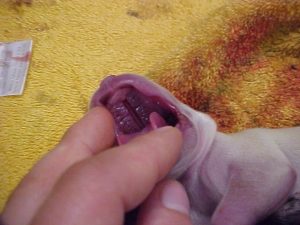
Photo of a puppy with a cleft palate
Dr. Marty Greer, DVM, JD, joins us for an important conversation about pre-breeding protocols. Greer provides insight on what to do (hint: folic acid!) and what not to do to help ensure a healthy litter.
Bitches who are to be bred should be started on a protocol 6-8 weeks ahead of estrus, Greer noted. Considerations include a proper diet, supplements and when to use flea, tick and heartworm treatments.
“We know from livestock and wildlife that when females are just slightly soft they produce more offspring,” Greer said. “They ovulate more if the caloric intake increases just before mating.”
Appropriate diets should include carbs, Greer said, and avoid phytoestrogens from peas/legumes. Owners should also supplement vitamin b9, folic acid, starting 2 months ahead of breeding to help prevent cleft palates. Greer recommends dosing 5mg/dog/day. For more information on some of the research on this topic, go to
http://www.woodhavenlabs.com/documents/FolicAcidCleftPalateRoyalCanin.pdf
Studies indicate that breeders can insure a 50-70 percent reduction of cleft palates by using folic acid properly.
Cleanliness is next to godliness
Make sure your bitch is clean before visiting the vet or having her puppies. A bath and sanitary trim will keep the vet and the puppies happier!
What NOT to do
Vitamins A and D in excess during the first two trimesters can *cause* cleft palates, Greer said. She also noted that while most of us know not to give steroids orally during pregnancy, that even topical application in ears or eyes is contraindicated.
More myth busting and important advice
- Can you or should you save cleft palate puppies — Greer shares some of the hard choices to be made
- Goats milk and cataracts — use an appropriate formula for dogs
- Colostrum/plasma — frozen plasma can make all the difference
- Subcu fluids — how and why
301 — Ring Stewards: The Unsung Heroes of the Dog Show
Ring Stewards: The Unsung Heroes of the Dog Show
Kevin Ellingson, member of the Professional Stewards Association of Northern California, started ring stewarding in 2006 as a way to learn more about the sport while his wife was showing Cavalier King Charles Spaniels .
Ellingson said a couple of the most important things he learned when he started stewarding were to “respect the judge’s time and that judges are people too.”
“Ring stewards are ambassadors to the dog show world,” Ellingson said. “For new exhibitors, stewards may well be their first contact with the sport.”
From the PSANC website:
“A good dog show steward makes the work of judging a dog show easier by relieving the judge of unnecessary details. By assembling classes promptly, one will be able to keep the judging on schedule and eliminate, to a large extent, delays between classes.
Main Professional Steward duties:
- Hand out armbands and mark absentees
- Confirm with the judge the procedures that s/he wish to see carried out
- Assemble classes promptly and check to see that those entering the ring are wearing the correct armband
- Keep an eye on the clock to make sure the judge is on time
- Keep an accurately marked catalog noting placements, absentees and disqualifications
- Prepare ribbon and trophy awards for each class
- Keep the ring neat and clean, watching to make sure everything is running smoothly
- Assist exhibitors (new, experienced, or professional) to make them comfortable and at ease; treat all exhibitors professionally and with courtesy and respect (be cautious to not be too familiar with exhibitors to ensure professionalism)
- Contact show photographer, superintendent, or AKC Representative as needed
- In general, it is your duty to make the experience efficient and pleasurable for everyone.”
Learn more about this critical role at the dog shows. Ellingson provides a rundown of all the jobs the steward handles and why exhibitors should always be nice to the ring steward.
300 — Episode 300!! Favors, Table Training and Hot Dogs
Episode 300!! Favors, Table Training and Hot Dogs
Holy hot dogs batman… Episode 300?! How did THAT happen? Time flies when you’re having fun!
Honestly, a year ago, I wasn’t at all sure I’d make it this far. I’d just taken on sole ownership and management of PureDogTalk. I was running the show out of my own VERY shallow pocket and, frankly, scared to death… The fact that I decided to retire from a 25 year long professional handling career, start a year-long ENORMOUS home remodeling project AND take this on full time, pretty much all in the same month, speaks to either my courage or my sanity, depending on your perspective! Lol
Patrons
Hindsight being what it is, I probably *could* have managed this all a bit more smoothly, but, the gods are kind to crazy people … today the Patrons Support is growing steadily – a HUGE shoutout to those of you who supported the show early and faithfully… YOU literally are the reason there is a podcast today… I’d love to have even more folks join our outstanding community of PureDogTalk Patrons. For as little as $5/month, you, too, can be counted as supporters of GREAT content and education for the entire purebred dog fancy. These funds are earmarked exclusively for operating expenses. Website upgrades and more are on the list when that pot of gold grows just a little bit more… Just Click the “Be my patron on Podbean” button on the homepage at www.puredogtalk.com
Meanwhile, we have another VERY exciting and VERY cool partnership to announce in the VERY near future… Yep, this is a tease… Watch this space…
So, with all that business out of the way, here’s a thing…. I LOVE doing this job. It not only combines my passions – dogs, talking dogs and helping people – but *I* literally learn something every single day.
Metaphor
And, what’s our teaching moment for today? This podcast is a perfect metaphor for your life in dogs! How you say? Try this out.
- Follow your passion.
- Take chances, even when they are SUPER scary.
- Seek and find the positive in every. Single. Day. Even when you have to dig for it. Maybe even especially when you have to dig for it.
- Nothing worthwhile is handed to you.
- Nothing is “deserved”… everything is “earned.”
- Competition, even from the REALLY big guns, makes you better, sharper and tougher.
- Doing well and doing good are NOT incompatible.
- Helping others does as much or more for you as for them.
- Kindness is free. Sprinkle that shit everywhere.
- As soon as you say, I can’t do this stuff, stop and think about it. I did. And I had some pretty significant obstacles along the way. Literally, if I can do it, you can do it.
Back in the day, before I had a twice weekly podcast, I had a weekly magazine column called As the Wheels Turn… Here’s a little Throwback Thursday to celebrate moving forward.
Peace, Love and a Favor for a Friend
“When I first started, I was amazed by the ‘trading favors’ system,” said a young handler friend recently. Her comment sort of startled me, and got me thinking about this unique and worthy tradition in the sport. “I mean, wait, what? You show my dog and I get paid? What’s that about? What other job is that a thing? I mean I can’t just go sing somebody else’s concert.”
This is not a secret, by any means, in the tribe of professional handlers, but it is a quiet reality. We all help each other. It’s part of our unwritten code of ethics. Conflicts frequently require covering and an assistant is not always available or the right person for the job.
Enter the world of handlers and their network of friends and acquaintances trusted to help show the dogs on their string. The “hat in hand” look when somebody shows up at your setup at [7:15]… “What do YOU have at 8 (or [9:15] or [10:30])?” Or the frantic arm wave from a ring that’s running long as you stroll by, “Can you go take that dog in? I’ll try to make it.” And if you are able, you do it, gladly, so that when YOU have a giant cluster the next day, or the next week or the next month, you have favors “in the bank” so to speak.
Additional unwritten rules:
- Don’t hand off a problem dog. I once, as a young handler, had somebody hand me a very spooky Dalmation and say, “Here, go show this.” I did, the dog freaked on the exam and was excused. This makes me look bad and is not the way to “win friends and influence people.”
- Give fair value. If you need help, be sure to offer help to others. What goes around really does come back around — either good or bad!
- Don’t hustle your friends’ clients! And, on the flip side, be aware that if you hand their dogs off too often, your clients may go looking for a new handler…
- For the clients, try to be fair and reasonable with your handler. You have hired them to do the best for your dog. Trust their knowledge and experience and let them do their job. As much as most of us have longed to be cloned, it hasn’t happened yet and we can only be in one place at a time.
Handling Tips FAQ — Table Training
Summer Solstice has arrived. Long hours of daylight and bored kids. Dog shows around every corner in every state and nation. Time to tune up Fido, load the wagon and head for a fairgrounds near you.
One thing we haven’t gotten to is working with table dogs. This also applies to teaching puppies of larger breeds the fundamentals of stacking.
Funny story
Growing up, my family never invested in a grooming table. I groomed dogs on the ground. I taught puppies and dogs to stack — on the ground. I spent a LOT of time on my knees. I bought my very first grooming table when I started showing dogs for other people. I showed large and giant breeds. The first time I *ever* put a dog on a table to be examined was while helping Don Rodgers (may he Rest in Peace) and Pat with a gazillion Shih Tzu at one of the Idaho summer shows. It was nearly a quarter century ago this week and emblazoned in my psyche for life. I’d been assigned a black dog (already an uphill battle as I’ve come to learn) and we were showing to Joe Tacker. The wind was blowing (as it always does in idaho) and I thought I’d be SO smart and face the dog into the wind…. Which, PS, was backwards. Mr. Tacker approached the table. Looked at the dog. Looked at me. And said, “I bet you didn’t think I knew which end was which!” To which I responded in absolute mortification, “I knew they paid you the big bucks for a reason!” while rapidly spinning the dog around to face the proper direction. Oh. Dear. God. I’m pretty sure I still have the scars from the daggers Don was staring into my back. I did manage to get RWD, but my humiliation was complete. It took MANY years before I next attempted a table breed…
The last dozen years or so, I’ve had lots of opportunities to improve my skills. I have found two methods which both work well for me, depending on the personality and temperament of the dog I’m training.
Can’t Touch This
The first works really well for those independent, all-about-me, “I got this” little dogs who prefer the DIY method. Using the same technique described in the free stacking article below, put the dog at the back of the table and let them “walk up” into the stack.
This has the decided advantage of looking very impressive. It requires lots of confidence from both you and the dog. At best all you’ll have to do is fix a foot… The disadvantage is, without lots of practice, the dog may not be properly positioned in a timely manner and you’re left juggling with stacking while the judge watches.
If using this method, be sure to watch the judge’s preferred table procedure in advance. Everyone does it just a little different. *Generally* the dog is placed on the table as the dog before is moving in its individual pattern.
Scary Larry
This works well for the less confident dogs, the naughty rambunctious dogs and everything in between. Pick up the dog in a comfortable position, make sure the leash is properly out of the way around your neck (I STILL have an unfortunate habit of putting it the wrong way…), check that the table is steady, then quietly set the dog down. Lift gently under the chin and between the back legs to place squarely and towards the front of the table where the judge can easily reach him. Use the 1-2-3-4-5 method described in the basic stacking tips article to properly set the feet and present the dog.
Cookie Monster
I avoid feeding dogs bait on the table whenever possible. Just as feeding a dog on the ground before the exam, it sets a bad precedent for the dog to look for food from the hand coming toward him. For those dogs who are particularly food motivated, grab first and ask questions later can have unpleasant consequences when it’s the judge’s hand that’s “grabbed.”
Shazam
Table presentation, just like its equal on the ground, varies greatly between handlers and their charges. From standing in front at the end of a long lead, to standing beside and showcasing the head. Practice, try new things and then practice some more before using your technique in the ring.
Hot Dogs, Hot Shows and Hot Travel
I am a fanatic about servicing my dog vehicles — regular oil changes and maintenance — the slightest weird clunk and I’m running for the mechanic. Vehicle trouble with dogs on board is a major liability that I avoid like the plague. Over the years I’ve dealt with the occasional blown tire, dead batteries and the usual wear and tear items. Nonetheless, due to a rigid service schedule and a platoon of guardian angels, it is normally a minor headache rather than a huge crisis. I suppose I was overdue for a major fail, just by the law of averages. And it finally happened — three hours from anyone I knew who could rescue the dogs and I on a day that saw temperatures soar over 100 degrees.
When your vehicle is dead beside the freeway, you have to draw on preparation, roadside assistance and, frankly, all the good juju you can muster. My sprinter van was equipped with heavy duty insulation, a roof mounted AC unit, a roof fan and vent. Even with very proactive and insistent advocacy on my part, the dogs and I still sat for two hours with all the doors and windows open staying as cool as possible while awaiting a tow truck.
A faulty wire on an alternator installed two years ago was the eventual diagnosis. Lesson learned? Even if you’re SURE there could not possibly be anything wrong with the vehicle that was just serviced at the dealership a couple months ago, err on the side of caution. Better safe than sorry is a truism because, actually, it’s *true*!
Our amazing tribe of dog people came through with a dozen offers of help, even for driving three hours each way if needed, and eventually a place to crash for the night and get the dogs out.
This all goes to remind us that NONE of us is immune to the inherent dangers and risks of long hours on the road. No matter how diligent, how young and virile, how shielded by angels, every single time we take our dogs to the next venue, we need to be aware and prepared.
As we all gear up for the hot summer months, long hauls from Point A to Point B, little sleep, exhausting days and unending nights on the road, here are some important reminders:
Water: Never leave home without it. A gallon per dog is what I try to plan on when driving.
Shade: Whatever your preferred shade cloth, make sure it’s easily accessible in an emergency.
Air Flow: We and our dogs can all survive high temperatures (perhaps not in perfect comfort, but without serious concerns about life and death) as long we have sufficient air flow. Crate fans, roof fans, vents, windows, whatever it takes to keep the air moving.
Crates: Are our friends!!! My mother was nearly killed in a horrific car accident 25 years ago. The four puppies with her were safe and unharmed, largely due to traveling in dog crates.
Calm: A quiet dog who isn’t stressed by the situation will handle the heat far better. And remember, our dogs take their lead from us. If we are hysterical, the dogs will feel the stress and suffer more.
NEVER: Trust a generator or even electrical outlets to run AC. If it is hot, I simply do not leave my dogs. Far, far too many horrible scenes of devastation over the years could have been prevented with this one simple precaution. The lesson was drilled in to me the hard way many years ago, when my RV generator quit during a high elevation show in Colorado while I was at the group ring. The dogs were ok, but it could just as easily have gone the other way if I had dawdled on the way back, stopped to chit chat or socialize. Today’s temperature monitoring devices which call your phone with alerts are invaluable for short trips away), but nothing beats the peace of mind of simply having the rig supervised at all times.
Let’s keep ourselves and our doggies cool, hydrated and safe. Plan a water fight on the grounds, dress sensibly, and always remember — no ribbon is ever more important than your dog’s safety.


